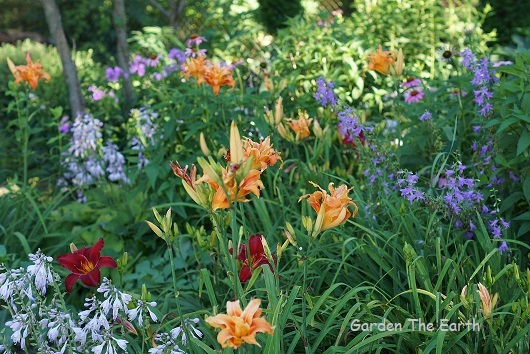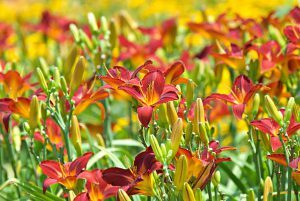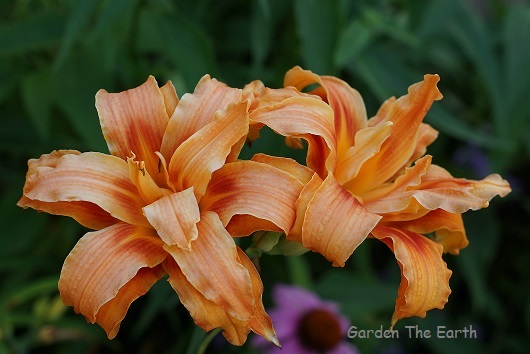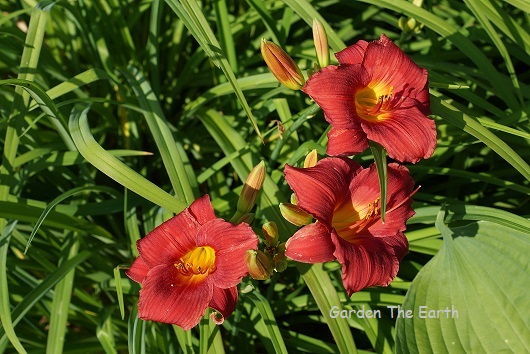Daylily
Daylily flowers are a gardener favorite due to ease of care, variety of colors and prolific blooms that sometimes provide secondary rounds in the fall. Blooming times vary with type so with planning, you can count on daylilies to be fillers and balance garden display.

A flower for a day
So named because of the characteristic of the flower to open and close in one day, their presence each year is precious. Knowing that that flower will only be there one day until the next year, I take the time to walk the gardens every day to appreciate their brief stay. It can be a great way to get kids involved in the wonder of gardening, watching the tiny bud grow and finally burst into a huge flower one morning.
The foliage of most daylilies is low growing, generally 2 to 2-1/2 feet high. Bloom stalks are 2-1/2 to 3-1/2 feet tall. Dwarf varieties are typically 1 to 2 feet tall.

Prolific flowers
Super productive, the amount of blooms one plant can provide is astounding! You can expect a mature plant to continue to bloom for up to two months. Different varieties bloom at different times, so with select placement, they will add color across the garden for several months. They reproduce quickly into large masses, but don’t slow flower production over time as quickly as some perennials do.

How to Grow Daylilies
Environment
Light: For best blooms, grow daylilies in full sun. They don’t bloom well or at all in shade, but the foliage will endure.
Water: Established daylilies will thrive in drought conditions. They do enjoy supplemental watering before and during the blooming season for best results. Spring rains are ideal to get them off to a good start. Established plants tolerate dry conditions better than newly planted specimens.
Soil: Daylilies tolerate almost any type of soil, but will perform their best in moist, well drained soil. They tolerate a pH range of 6 to 8.
Daylily maintenance
Drought resistant, and able to tolerate varied climate and environmental conditions, you frequently see them used around parking lots or malls, where they happily grow with little maintenance.
Leaves will turn yellow and die throughout the season and as regular maintenance, should be removed by gently pulling. This keeps the plants looking their best, encourages new growth, and discourages insect or fungal infestations. Even after the flowers are gone, their long graceful leaves make attractive visual formations, accents and borders in the garden.

Daylilies continue to bloom profusely for years as the mass grows. Sometimes I will just cut a section out of a mass to give them breathing room to rejuvenate and leave the rest in the ground. They will grow into the new soil quickly. It only takes one small root section to start a new plant so moving daylilies or separating them does not require digging up the whole mass unless desired.
In the fall, you can choose to cut the leaves off about 2 inches from the base or leave them until Spring. I prefer to let the leaves stay on during the winter. In the spring, the dead leaves are easily pulled or raked away from the plants before the shoots start to emerge.
This article may contain affiliate links. Click here for full disclosure.
Why didn’t my daylilies bloom?
Types of Daylilies
There are so many color combinations and petal forms you will want one of each! Many of the ones that I have came from mail order mixes and I have never been disappointed. There are also miniature varieties, which produce smaller masses and flowers such as Stella D’Oro in yellow and Pardon Me in red with yellow throat. My Stella D’Oro’s are the first daylily bloomers in spring, and as long as they are deadheaded, continue to bloom in spurts throughout the summer.
See a wide variety of DayliliesIf you are looking for a care-free perennial plant for your new garden or a specimen plant for your established garden, daylilies are a top choice.



Comments
Daylily — No Comments
HTML tags allowed in your comment: <a href="" title=""> <abbr title=""> <acronym title=""> <b> <blockquote cite=""> <cite> <code> <del datetime=""> <em> <i> <q cite=""> <s> <strike> <strong>